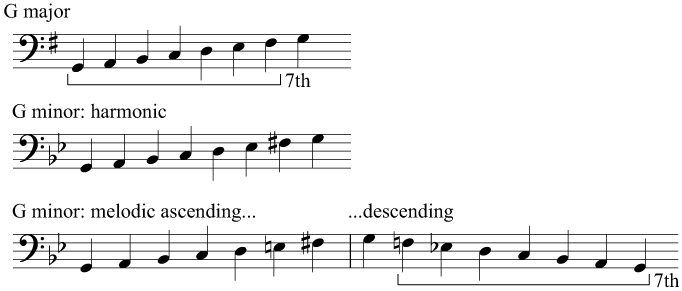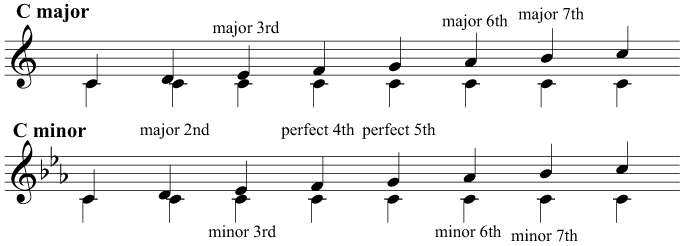Intervals level 3
In this guide...
Key terms:
Subscription required!
To view the complete study guide, you will need a valid subscription. Why not subscribe now?
Already have a subscription? Make sure you login first!
Introduction
We have already looked at the topic of intervals twice, in the level 1 study guide and the level 2 study guide. Now we're going to look at how we can more precisely name intervals.
A reminder
As a brief reminder of what we've already covered in the level 2 study guide, let's take a quick look at the intervals in A major and A minor.
 Intervals above the tonic in A major and A minor
Intervals above the tonic in A major and A minorSo far, so good - we know these numbered intervals, and we've met them in both melodic form (neighbouring notes) and harmonic form (stacked notes - as in the example above).
A closer look
Let's take a closer look, however, at the interval of a 3rd above the tonic in both of these keys. Remembering to observe the key signature, try playing them on your instrument or on a piano - they sound different!
The simple reason is that in A major, the 3rd is A to C sharp, whereas in A minor, the 3rd is A to C natural.
They can both correctly be called a 3rd, but we need a way to more precisely define them, so that we can tell the difference.
Both of these intervals are 3rds, but what type of 3rd are they?
Major and minor
In addition to the number of an interval, we will now also start talking about the quality of an interval, as a way of telling the difference between different types of 3rds, 6ths, and other intervals.
- A major 3rd is a 3rd like the one between A and C sharp, found in A major.
- A minor 3rd is a 3rd like the one between A and C natural, as found in A minor.
If you look at the example with the full A major scale above, you'll see that there are differences too in the 6ths between the major and minor scales.
Similarly, we can define a major 6th as a 6th like the one between A and F sharp in A major, and a minor 6th as a 6th like the one between A and F natural, in A minor.
Here are the same intervals, this time in F major and F minor.
 3rds and 6ths in F major and F minor
3rds and 6ths in F major and F minorLook closely!
If you think that these intervals look the same, look again!
The notes might appear the same - but the key signature means that the notes are different in F major and F minor, specifically the A natural in F major and the A flat in F minor.
Examiners love to trick you like this with the key signature, so always double check!
More precisely...
A good way to spot the difference between a major 3rd and a minor 3rd is simply to think which scale the interval would fit into, starting from the bottom note. So, given G and B flat, we can see immediately that this is a minor 3rd, because you find a B flat in G minor, but not in G major.
This technique relies on you knowing your scales and key signatures well, however, so as a back-up plan here's another way.
If you count the number of semitones in a minor and major 3rd, you'll see that there are 3 semitones in a minor 3rd, and 4 semitones in a major 3rd. Similarly, you will see that there are 8 semitones in a minor 6th and 9 semitones in a major 6th.
But, don't try and remember the number of semitones in each interval!
It's much easier to remember that major intervals are larger and minor intervals are smaller.
4ths and 5ths
If you look at the 5ths in both A major and A minor, you'll see that they are identical. These intervals are much more straightforward than 3rds and 6ths!
We still give them a quality, however - they are called the perfect 4th and the perfect 5th. Here they are in E major and E minor:
 4ths and 5ths in E major and E minor
4ths and 5ths in E major and E minor2nds and 7ths
Lastly, let's look at the differences between the 2nd and 7ths. You'll notice that they appear to be the same in both major and minor - but remember, we are only looking at the harmonic minor scale of A minor. What about the melodic minor?
Look at the following set of scales - for a change, let's look at G major and G minor.
 Scales of G major and G minor
Scales of G major and G minorThe 7th in G major is G to F sharp, but descending in G melodic minor, there's an F natural!
Just as with 3rds, we use the "major" and "minor" qualities with 7ths. The wider interval, G to F sharp, is called a major 7th, and the smaller interval (found only in the minor key, such as G to F natural) is called a minor 7th.
This minor 7th is in fact simply the 7th that you would expect from the key signature, without any accidentals, as you can see here:
 7ths in G major and G minor
7ths in G major and G minor2nds: a special case
The 2nd that is the same in both major and minor keys is not called a "perfect 2nd" as you might guess, based on 4ths and 5ths, but it's called a major 2nd. It's also the same interval as a tone.
Therefore, you can probably guess what kind of 2nd a semitone is: a minor 2nd!
A warning about minor keys!
As you can see from the harmonic minor scale (and also the ascending melodic minor scale) - just because it's a minor key, it doesn't mean that every 6th or 7th you see in a minor key is a minor 6th or 7th!
Watch out for accidentals in 6th and 7ths in a minor key, and remember that major intervals are bigger than minor intervals.
if in doubt you can take the last resort: How many semitones?
- There are 8 semitones in a minor 6th, and 9 in a major 6th
- There are 10 in a minor 7th, and 11 in a major 7th
Always check first, though, that the interval is definitely a 6th or a 7th, by counting up the steps from the bottom note!
In summary
This "quality and type" system can be overwhelming at first, so let's recap and look at examples of each.
- 2nds, 3rds, 6ths, 7ths: major or minor
- 4ths and 5ths only: perfect
- major: bigger!
- minor: smaller!
 Intervals above the tonic in C major and C minor
Intervals above the tonic in C major and C minorRead more...
With a subscription to Clements Theory you'll be able to read this and dozens of other study guides, along with thousands of practice questions and more! Why not subscribe now?
Revision
Are you sure you've understood everything in this study guide? Why not try the following practice questions, just to be sure!